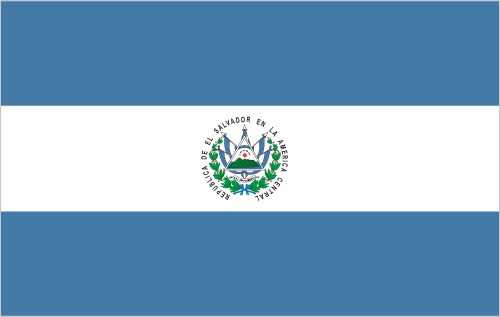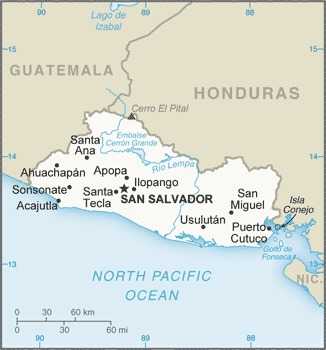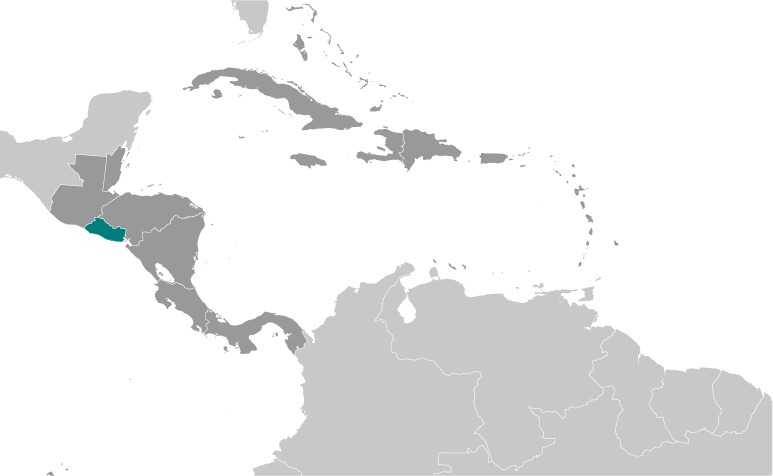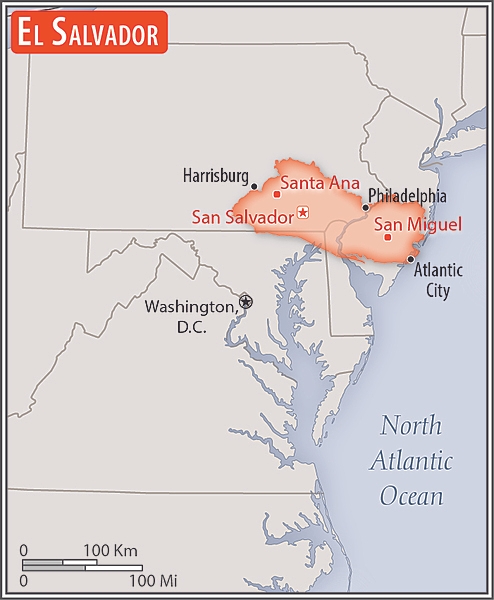Introduction
Background
El Salvador achieved independence from Spain in 1821 and from the Central American Federation in 1839. A 12-year civil war, which cost about 75,000 lives, was brought to a close in 1992 when the government and leftist rebels signed a treaty that provided for military and political reforms. El Salvador is beset by one of the world's highest homicide rates and pervasive criminal gangs.
Visit the Definitions and Notes page to view a description of each topic.
Geography
Location
Central America, bordering the North Pacific Ocean, between Guatemala and Honduras
Geographic coordinates
13 50 N, 88 55 W
Map references
Central America and the Caribbean
Land boundaries
total: 590 km
border countries (2): Guatemala 199 km; Honduras 391 km
Coastline
307 km
Maritime claims
territorial sea: 12 nm
contiguous zone: 24 nm
exclusive economic zone: 200 nm
Climate
tropical; rainy season (May to October); dry season (November to April); tropical on coast; temperate in uplands
Terrain
mostly mountains with narrow coastal belt and central plateau
Elevation
highest point: Cerro El Pital 2,730 m
lowest point: Pacific Ocean 0 m
mean elevation: 442 m
Natural resources
hydropower, geothermal power, petroleum, arable land
Land use
agricultural land: 74.7% (2018 est.)
arable land: 33.1% (2018 est.)
permanent crops: 10.9% (2018 est.)
permanent pasture: 30.7% (2018 est.)
forest: 13.6% (2018 est.)
other: 11.7% (2018 est.)
Irrigated land
274 sq km (2020)
Population distribution
athough it is the smallest country in land area in Central America, El Salvador has a population that is 18 times larger than Belize; at least 20% of the population lives abroad; high population density country-wide, with particular concentration around the capital of San Salvador
Natural hazards
known as the Land of Volcanoes; frequent and sometimes destructive earthquakes and volcanic activity; extremely susceptible to hurricanes
volcanism: significant volcanic activity; San Salvador (1,893 m), which last erupted in 1917, has the potential to cause major harm to the country's capital, which lies just below the volcano's slopes; San Miguel (2,130 m), which last erupted in 2002, is one of the most active volcanoes in the country; other historically active volcanoes include Conchaguita, Ilopango, Izalco, and Santa Ana
Geography - note
smallest Central American country and only one without a coastline on the Caribbean Sea
People and Society
Population
total: 6,628,702
male: 3,172,244
female: 3,456,458 (2024 est.)
comparison rankings: female 107; male 110; total 110
Nationality
noun: Salvadoran(s)
adjective: Salvadoran
Ethnic groups
Mestizo 86.3%, White 12.7%, Indigenous 0.2% (includes Lenca, Kakawira, Nahua-Pipil), Black 0.1%, other 0.6% (2007 est.)
Languages
Spanish (official), Nawat (among some Indigenous)
major-language sample(s):
La Libreta Informativa del Mundo, la fuente indispensable de información básica. (Spanish)
The World Factbook, the indispensable source for basic information.
Religions
Roman Catholic 43.9%, Protestant 39.6% (Evangelical - unspecified 38.2%, Evangelical - Methodist 1.3%, Evangelical - Baptist 0.1%), none 16.3%, unspecified 0.2% (2023 est.)
Demographic profile
El Salvador is the smallest and most densely populated country in Central America. It is well into its demographic transition, experiencing slower population growth, a decline in its number of youths, and the gradual aging of its population. The increased use of family planning has substantially lowered El Salvador's fertility rate, from approximately 6 children per woman in the 1970s to replacement level today. A 2008 national family planning survey showed that female sterilization remained the most common contraception method in El Salvador - its sterilization rate is among the highest in Latin America and the Caribbean - but that the use of injectable contraceptives is growing. Fertility differences between rich and poor and urban and rural women are narrowing.
Salvadorans fled during the 1979 to 1992 civil war mainly to the United States but also to Canada and to neighboring Mexico, Guatemala, Honduras, Nicaragua, and Costa Rica. Emigration to the United States increased again in the 1990s and 2000s as a result of deteriorating economic conditions, natural disasters (Hurricane Mitch in 1998 and earthquakes in 2001), and family reunification. At least 20% of El Salvador's population lives abroad. The remittances they send home account for close to 20% of GDP, are the second largest source of external income after exports, and have helped reduce poverty.
Age structure
0-14 years: 25.3% (male 855,841/female 818,642)
15-64 years: 66.3% (male 2,077,745/female 2,317,416)
65 years and over: 8.4% (2024 est.) (male 238,658/female 320,400)
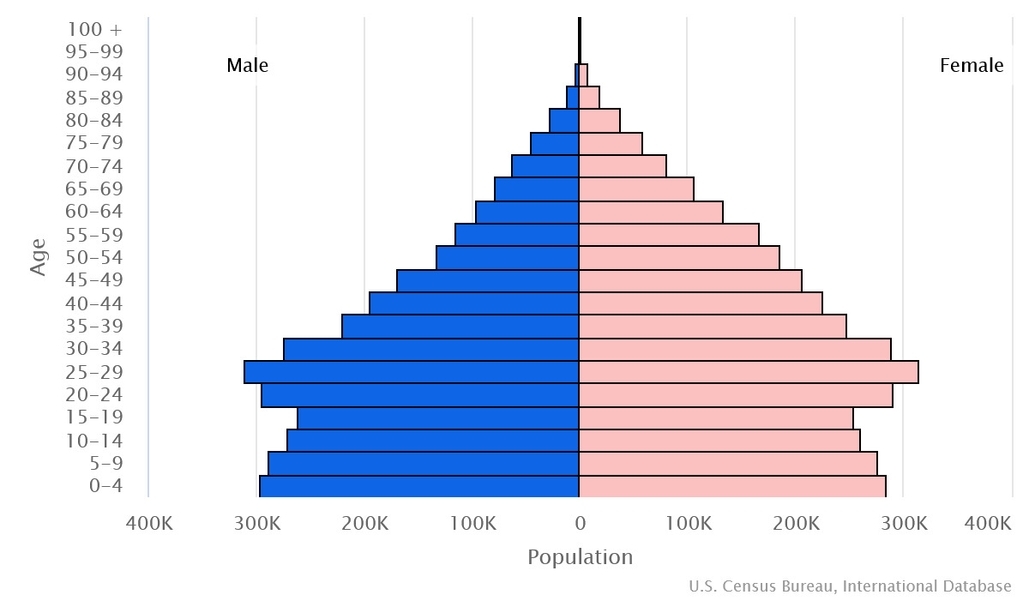
Dependency ratios
total dependency ratio: 51.3
youth dependency ratio: 39
elderly dependency ratio: 12.3
potential support ratio: 8.1 (2021 est.)
Median age
total: 29.7 years (2024 est.)
male: 28.2 years
female: 31.2 years
comparison ranking: total 143
Population distribution
athough it is the smallest country in land area in Central America, El Salvador has a population that is 18 times larger than Belize; at least 20% of the population lives abroad; high population density country-wide, with particular concentration around the capital of San Salvador
Urbanization
urban population: 75.4% of total population (2023)
rate of urbanization: 1.33% annual rate of change (2020-25 est.)
Major urban areas - population
1.116 million SAN SALVADOR (capital) (2023)
Sex ratio
at birth: 1.05 male(s)/female
0-14 years: 1.05 male(s)/female
15-64 years: 0.9 male(s)/female
65 years and over: 0.74 male(s)/female
total population: 0.92 male(s)/female (2024 est.)
Mother's mean age at first birth
20.8 years (2008 est.)
note: data represents median age at first birth among women 25-29
Infant mortality rate
total: 11.7 deaths/1,000 live births (2024 est.)
male: 13.3 deaths/1,000 live births
female: 10 deaths/1,000 live births
comparison ranking: total 112
Life expectancy at birth
total population: 75.9 years (2024 est.)
male: 72.4 years
female: 79.5 years
comparison ranking: total population 121
Gross reproduction rate
0.98 (2024 est.)
Contraceptive prevalence rate
71.9% (2014)
Drinking water source
improved: urban: 99.6% of population
rural: 94.2% of population
total: 98.2% of population
unimproved: urban: 0.4% of population
rural: 5.8% of population
total: 1.8% of population (2020 est.)
Current health expenditure
9.9% of GDP (2020)
Physician density
2.87 physicians/1,000 population (2018)
Hospital bed density
1.2 beds/1,000 population (2017)
Sanitation facility access
improved: urban: 100% of population
rural: 97.1% of population
total: 99.2% of population
unimproved: urban: 0% of population
rural: 2.9% of population
total: 0.8% of population (2020 est.)
Major infectious diseases
degree of risk: high (2023)
food or waterborne diseases: bacterial and protozoal diarrhea
vectorborne diseases: dengue fever
Alcohol consumption per capita
total: 2.94 liters of pure alcohol (2019 est.)
beer: 1.5 liters of pure alcohol (2019 est.)
wine: 0.06 liters of pure alcohol (2019 est.)
spirits: 1.37 liters of pure alcohol (2019 est.)
other alcohols: 0 liters of pure alcohol (2019 est.)
comparison ranking: total 116
Tobacco use
total: 7.9% (2020 est.)
male: 14.1% (2020 est.)
female: 1.7% (2020 est.)
comparison ranking: total 151
Currently married women (ages 15-49)
55% (2023 est.)
Child marriage
women married by age 15: 4.3%
women married by age 18: 19.7% (2021 est.)
Literacy
definition: age 15 and over can read and write
total population: 89.1%
male: 91.3%
female: 87.3% (2019)
School life expectancy (primary to tertiary education)
total: 12 years
male: 12 years
female: 12 years (2018)
Environment
Environment - current issues
deforestation; soil erosion; water pollution; contamination of soils from disposal of toxic wastes
Environment - international agreements
party to: Biodiversity, Climate Change, Climate Change-Kyoto Protocol, Climate Change-Paris Agreement, Comprehensive Nuclear Test Ban, Desertification, Endangered Species, Hazardous Wastes, Nuclear Test Ban, Ozone Layer Protection, Ship Pollution, Wetlands
signed, but not ratified: Law of the Sea
Climate
tropical; rainy season (May to October); dry season (November to April); tropical on coast; temperate in uplands
Land use
agricultural land: 74.7% (2018 est.)
arable land: 33.1% (2018 est.)
permanent crops: 10.9% (2018 est.)
permanent pasture: 30.7% (2018 est.)
forest: 13.6% (2018 est.)
other: 11.7% (2018 est.)
Urbanization
urban population: 75.4% of total population (2023)
rate of urbanization: 1.33% annual rate of change (2020-25 est.)
Air pollutants
particulate matter emissions: 22.15 micrograms per cubic meter (2019 est.)
carbon dioxide emissions: 7.17 megatons (2016 est.)
methane emissions: 4.71 megatons (2020 est.)
Waste and recycling
municipal solid waste generated annually: 1,648,996 tons (2010 est.)
Total water withdrawal
municipal: 470 million cubic meters (2020 est.)
industrial: 210 million cubic meters (2020 est.)
agricultural: 1.43 billion cubic meters (2020 est.)
Total renewable water resources
26.27 billion cubic meters (2020 est.)
Government
Country name
conventional long form: Republic of El Salvador
conventional short form: El Salvador
local long form: República de El Salvador
local short form: El Salvador
etymology: name is an abbreviation of the original Spanish conquistador designation for the area "Provincia de Nuestro Senor Jesus Cristo, el Salvador del Mundo" (Province of Our Lord Jesus Christ, the Saviour of the World), which became simply "El Salvador" (The Savior)
Government type
presidential republic
Capital
name: San Salvador
geographic coordinates: 13 42 N, 89 12 W
time difference: UTC-6 (1 hour behind Washington, DC, during Standard Time)
etymology: Spanish for "Holy Savior" (referring to Jesus Christ)
Administrative divisions
14 departments (departamentos, singular - departamento); Ahuachapan, Cabanas, Chalatenango, Cuscatlan, La Libertad, La Paz, La Union, Morazan, San Miguel, San Salvador, San Vicente, Santa Ana, Sonsonate, Usulutan
Independence
15 September 1821 (from Spain)
National holiday
Independence Day, 15 September (1821)
Constitution
history: many previous; latest drafted 16 December 1983, enacted 23 December 1983
amendments: proposals require agreement by absolute majority of the Legislative Assembly membership; passage requires at least two-thirds majority vote of the Assembly; constitutional articles on basic principles, and citizen rights and freedoms cannot be amended; amended 2003, 2009, 2014
Legal system
civil law system with minor common law influence; judicial review of legislative acts in the Supreme Court
International law organization participation
has not submitted an ICJ jurisdiction declaration; non-party state to the ICCt
Citizenship
citizenship by birth: yes
citizenship by descent only: yes
dual citizenship recognized: yes
residency requirement for naturalization: 5 years
Suffrage
18 years of age; universal
Executive branch
chief of state: President Nayib Armando BUKELE Ortez (since 1 June 2019)
head of government: President Nayib Armando BUKELE Ortez (since 1 June 2019)
cabinet: Council of Ministers selected by the president
elections/appointments: president and vice president directly elected on the same ballot by absolute majority popular vote in 2 rounds if needed for a single 5-year term; election last held on 4 February 2024 (next to be held in 2029)
election results: 2024: Nayib Armando BUKELE Ortez reelected president - Nayib Armando BUKELE Ortez (Nuevas Ideas) 84.7%, Manuel FLORES (FMLN) 6.4%, Joel SANCHEZ (ARENA) 5.6%, Luis PARADA (NT) 2%, other 1.3%
2019: Nayib Armando BUKELE Ortez elected president - Nayib Armando BUKELE Ortez (GANA) 53.1%, Carlos CALLEJA Hakker (ARENA) 31.7%, Hugo MARTINEZ (FMLN) 14.4%, other 0.8%
note: the president is both chief of state and head of government
Legislative branch
description: unicameral Legislative Assembly or Asamblea Legislativa (84 seats; members directly elected in multi-seat constituencies and a single nationwide constituency by open-list proportional representation vote to serve 3-year terms)
elections: last held on 28 February 2021 (next to be held in 2024)
election results: percent of vote by party - NI 66.5%, ARENA 12.2%, FMLN 6.9%, GANA 5.3%, PCN 4.1%, other 5%; seats by party - NI 56, ARENA 14, GANA 5, FMLN 4, other 5; composition - men 61, women 23, percent of women 27.4%
Judicial branch
highest court(s): Supreme Court or Corte Suprema de Justicia (consists of 15 judges, including its president, and 15 substitute judges organized into Constitutional, Civil, Penal, and Administrative Conflict Chambers)
judge selection and term of office: judges elected by the Legislative Assembly on the recommendation of both the National Council of the Judicature, an independent body elected by the Legislative Assembly, and the Bar Association; judges elected for 9-year terms, with renewal of one-third of membership every 3 years; consecutive reelection is allowed
subordinate courts: Appellate Courts; Courts of First Instance; Courts of Peace
Political parties and leaders
Christian Democratic Party or PDC [Reynaldo CARBALLO]
Farabundo Marti National Liberation Front or FMLN [Oscar ORTIZ]
Great Alliance for National Unity or GANA [Nelson GUARDADO]
National Coalition Party or PCN [Manuel RODRIGUEZ]
Nationalist Republican Alliance or ARENA [Erick SALGUERO]
New Ideas (Nuevas Ideas) or NI [Xavier Zablah BUKELE]
Our Time (Nuestro Tiempo) or NT [Juan VALIENTE]
Vamos or V [Josue ALVARADO Flores]
International organization participation
ACS, BCIE, CACM, CD, CELAC, FAO, G-11, G-77, IADB, IAEA, IBRD, ICAO, ICC (national committees), ICRM, IDA, IFAD, IFC, IFRCS, ILO, IMF, IMO, Interpol, IOC, IOM, IPU, ISO (correspondent), ITSO, ITU, ITUC (NGOs), LAES, LAIA (observer), MIGA, MINURSO, MINUSTAH, NAM (observer), OAS, OPANAL, OPCW, Pacific Alliance (observer), PCA, Petrocaribe, SICA, UN, UNCTAD, UNESCO, UNIDO, UNIFIL, Union Latina, UNISFA, UNMISS, UNOCI, UNOOSA, UNWTO, UPU, WCO, WFTU (NGOs), WHO, WIPO, WMO, WTO
Diplomatic representation in the US
chief of mission: Ambassador Carmen Milena MAYORGA VALERA (since 23 December 2020)
chancery: 1400 16th Street NW, Suite 100, Washington, DC 20036
telephone: [1] (202) 595-7500
FAX: [1] (202) 232-3763
email address and website:
infoEEUU@rree.gob.sv
consulate(s) general: Aurora (CO), Boston, Charlotte (NC), Chicago, Dallas, Doral (FL), Duluth (GA), El Paso (TX), Elizabeth (NJ), Fresno (CA), Houston, Las Vegas (NV), Laredo (TX), Long Island (NY), Los Angeles, McAllen (TX), New York, Omaha (NE), San Bernardino (CA), San Francisco, Salt Lake City, Seattle, Silver Spring (MD), Springdale (AR), St. Paul (MN), Tucson (AZ), Woodbridge (VA)
Diplomatic representation from the US
chief of mission: Ambassador William H. DUNCAN (since 24 January 2023)
embassy: Final Boulevard Santa Elena, Antiguo Cuscatlan, La Libertad, San Salvador
mailing address: 3450 San Salvador Place, Washington, DC 20521-3450
telephone: [503] 2501-2999
FAX: [503] 2501-2150
email address and website:
ACSSanSal@state.gov
https://sv.usembassy.gov/
Flag description
three equal horizontal bands of cobalt blue (top), white, and cobalt blue with the national coat of arms centered in the white band; the coat of arms features a round emblem encircled by the words REPUBLICA DE EL SALVADOR EN LA AMERICA CENTRAL; the banner is based on the former blue-white-blue flag of the Federal Republic of Central America; the blue bands symbolize the Pacific Ocean and the Caribbean Sea, while the white band represents the land between the two bodies of water, as well as peace and prosperity
note: similar to the flag of Nicaragua, which has a different coat of arms centered in the white band; also similar to the flag of Honduras, which has five blue stars arranged in an X pattern centered in the white band
National symbol(s)
turquoise-browed motmot (bird); national colors: blue, white
National anthem
name: "Himno Nacional de El Salvador" (National Anthem of El Salvador)
lyrics/music: Juan Jose CANAS/Juan ABERLE
note: officially adopted 1953, in use since 1879; at 4:20 minutes, the anthem of El Salvador is one of the world's longest
National heritage
total World Heritage Sites: 1 (cultural)
selected World Heritage Site locales: Joya de Cerén Archaeological Site
Economy
Economic overview
growth-challenged Central American economy buttressed via remittances; dense labor force; fairly aggressive COVID-19 stimulus plan; new and lower banking reserve requirements; earthquake, tropical storm, and crime disruptions; widespread corruption
Real GDP (purchasing power parity)
$71.957 billion (2023 est.)
$69.516 billion (2022 est.)
$67.623 billion (2021 est.)
note: data in 2021 dollars
comparison ranking: 107
Real GDP growth rate
3.51% (2023 est.)
2.8% (2022 est.)
11.9% (2021 est.)
note: annual GDP % growth based on constant local currency
comparison ranking: 90
Real GDP per capita
$11,300 (2023 est.)
$11,000 (2022 est.)
$10,700 (2021 est.)
note: data in 2021 dollars
comparison ranking: 144
GDP (official exchange rate)
$34.016 billion (2023 est.)
note: data in current dollars at official exchange rate
Inflation rate (consumer prices)
4.05% (2023 est.)
7.2% (2022 est.)
3.47% (2021 est.)
note: annual % change based on consumer prices
comparison ranking: 83
Credit ratings
Fitch rating: B- (2017)
Moody's rating: B3 (2018)
Standard & Poors rating: B- (2018)
note: The year refers to the year in which the current credit rating was first obtained.
GDP - composition, by sector of origin
agriculture: 12% (2017 est.)
industry: 27.7% (2017 est.)
services: 60.3% (2017 est.)
comparison rankings: services 123; industry 96; agriculture 78
GDP - composition, by end use
household consumption: 84.5% (2017 est.)
government consumption: 15.8% (2017 est.)
investment in fixed capital: 16.9% (2017 est.)
investment in inventories: 0% (2017 est.)
exports of goods and services: 27.6% (2017 est.)
imports of goods and services: -44.9% (2017 est.)
Agricultural products
sugarcane, maize, milk, chicken, beans, sorghum, coconuts, oranges, eggs, yautia (2022)
note: top ten agricultural products based on tonnage
Industries
food processing, beverages, petroleum, chemicals, fertilizer, textiles, furniture, light metals
Industrial production growth rate
4.12% (2023 est.)
note: annual % change in industrial value added based on constant local currency
comparison ranking: 75
Labor force
2.87 million (2023 est.)
note: number of people ages 15 or older who are employed or seeking work
comparison ranking: 114
Unemployment rate
2.76% (2023 est.)
3% (2022 est.)
4.33% (2021 est.)
note: % of labor force seeking employment
comparison ranking: 38
Youth unemployment rate (ages 15-24)
total: 13.7% (2021 est.)
male: 11.3%
female: 18.3%
comparison ranking: total 129
Population below poverty line
26.6% (2022 est.)
note: % of population with income below national poverty line
Gini Index coefficient - distribution of family income
38.8 (2022 est.)
note: index (0-100) of income distribution; higher values represent greater inequality
comparison ranking: 60
Average household expenditures
on food: 26.5% of household expenditures (2021 est.)
on alcohol and tobacco: 0.5% of household expenditures (2021 est.)
Household income or consumption by percentage share
lowest 10%: 1.9% (2022 est.)
highest 10%: 28.7% (2022 est.)
note: % share of income accruing to lowest and highest 10% of population
Remittances
23.94% of GDP (2023 est.)
24.05% of GDP (2022 est.)
25.74% of GDP (2021 est.)
note: personal transfers and compensation between resident and non-resident individuals/households/entities
Budget
revenues: $6.448 billion (2019 est.)
expenditures: $7.273 billion (2019 est.)
Public debt
66.47% of GDP (2021 est.)
70.38% of GDP (2020 est.)
53.88% of GDP (2019 est.)
note: central government debt as a % of GDP
comparison ranking: 62
Taxes and other revenues
19.69% (of GDP) (2021 est.)
note: central government tax revenue as a % of GDP
comparison ranking: 88
Current account balance
-$465.688 million (2023 est.)
-$2.182 billion (2022 est.)
-$1.25 billion (2021 est.)
note: balance of payments - net trade and primary/secondary income in current dollars
comparison ranking: 119
Exports
$10.629 billion (2023 est.)
$10.164 billion (2022 est.)
$8.351 billion (2021 est.)
note: balance of payments - exports of goods and services in current dollars
comparison ranking: 114
Exports - partners
US 38%, Guatemala 16%, Honduras 16%, Nicaragua 7%, Costa Rica 4% (2022)
note: top five export partners based on percentage share of exports
Exports - commodities
garments, plastic products, electrical capacitors, fabric, raw sugar (2022)
note: top five export commodities based on value in dollars
Imports
$17.032 billion (2023 est.)
$18.184 billion (2022 est.)
$15.483 billion (2021 est.)
note: balance of payments - imports of goods and services in current dollars
comparison ranking: 103
Imports - partners
US 30%, China 16%, Guatemala 12%, Mexico 8%, Honduras 6% (2022)
note: top five import partners based on percentage share of imports
Imports - commodities
refined petroleum, garments, natural gas, plastic products, plastics (2022)
note: top five import commodities based on value in dollars
Reserves of foreign exchange and gold
$3.426 billion (2021 est.)
$3.083 billion (2020 est.)
$4.446 billion (2019 est.)
note: holdings of gold (year-end prices)/foreign exchange/special drawing rights in current dollars
comparison ranking: 110
Exchange rates
the US dollar is used as a medium of exchange and circulates freely in the economy
Energy
Electricity access
electrification - total population: 100% (2022 est.)
Electricity
installed generating capacity: 2.853 million kW (2022 est.)
consumption: 6.666 billion kWh (2022 est.)
exports: 85.75 million kWh (2022 est.)
imports: 1.351 billion kWh (2022 est.)
transmission/distribution losses: 953.156 million kWh (2022 est.)
comparison rankings: transmission/distribution losses 96; imports 72; exports 89; consumption 120; installed generating capacity 111
Electricity generation sources
fossil fuels: 9.1% of total installed capacity (2022 est.)
solar: 16.2% of total installed capacity (2022 est.)
hydroelectricity: 35.6% of total installed capacity (2022 est.)
geothermal: 24.8% of total installed capacity (2022 est.)
biomass and waste: 14.3% of total installed capacity (2022 est.)
Coal
consumption: 500 metric tons (2022 est.)
imports: 2,000 metric tons (2022 est.)
Petroleum
total petroleum production: 3 bbl/day (2023 est.)
refined petroleum consumption: 58,000 bbl/day (2022 est.)
Natural gas
consumption: 226.472 million cubic meters (2022 est.)
imports: 226.472 million cubic meters (2022 est.)
Carbon dioxide emissions
8.256 million metric tonnes of CO2 (2022 est.)
from coal and metallurgical coke: 1,000 metric tonnes of CO2 (2022 est.)
from petroleum and other liquids: 7.814 million metric tonnes of CO2 (2022 est.)
from consumed natural gas: 441,000 metric tonnes of CO2 (2022 est.)
comparison ranking: total emissions 116
Communications
Telephones - fixed lines
total subscriptions: 863,000 (2022 est.)
subscriptions per 100 inhabitants: 14 (2022 est.)
comparison ranking: total subscriptions 74
Telephones - mobile cellular
total subscriptions: 11.509 million (2022 est.)
subscriptions per 100 inhabitants: 182 (2022 est.)
comparison ranking: total subscriptions 87
Telecommunication systems
general assessment: El Salvador is the smallest country in central America geographically, it has the fourth largest economy in the region; the country’s telecom sector has been restricted by poor infrastructure and unequal income distribution; there have been organizational delays which have slowed the development of telecom services; El Salvador’s fixed-line teledensity is substantially lower than the Latin American and Caribbean average; there has been a significant drop in the number of fixed lines since 2010, particularly in 2017, largely due to the substitution for mobile-only alternatives; about 94% of all telephony lines in the country are on mobile networks; mobile subscriptions are remarkably high considering El Salvador’s economic indicators, being about a third higher than average for Latin America and the Caribbean; the country was one of the last in the region to provide LTE services, mainly due to the inadequate provision of suitable spectrum; the multi-spectrum auction conducted at the end of 2019 has allowed MNOs to improve the reach and quality of their service offerings; El Salvador’s telecom legislation is one of the more liberal in Latin America, encouraging competition in most areas and permitting foreign investment; there are no regulations which promote wholesale broadband; the only effective cross-platform competition in the broadband market comes from the few cable operators; there has been some market consolidation in recent years (2021)
domestic: fixed-line services, roughly 14 per 100, mobile-cellular competition now at 175 subscribers per 100 inhabitants (2021)
international: country code - 503; satellite earth station - 1 Intelsat (Atlantic Ocean); connected to Central American Microwave System (2019)
Broadcast media
multiple privately owned national terrestrial TV networks, supplemented by cable TV networks that carry international channels; hundreds of commercial radio broadcast stations and two known government-owned radio broadcast station; transition to digital transmission to begin in 2018 along with adaptation of the Japanese-Brazilian Digital Standard (ISDB-T) (2022)
Internet users
total: 3.969 million (2021 est.)
percent of population: 63% (2021 est.)
comparison ranking: total 110
Broadband - fixed subscriptions
total: 586,000 (2020 est.)
subscriptions per 100 inhabitants: 9 (2020 est.)
comparison ranking: total 87
Transportation
National air transport system
number of registered air carriers: 1 (2020)
inventory of registered aircraft operated by air carriers: 13
annual passenger traffic on registered air carriers: 2,545,105 (2018)
annual freight traffic on registered air carriers: 10.73 million (2018) mt-km
Railways
total: 12.5 km (2014)
narrow gauge: 12.5 km (2014) 0.914-mm gauge
comparison ranking: total 136
Waterways
422 km (2022) (Rio Lempa River is partially navigable by small craft)
comparison ranking: 96
Ports
total ports: 3 (2024)
large: 0
medium: 0
small: 0
very small: 3
ports with oil terminals: 3
key ports: Acajutla, Acajutla Offshore Terminal, La Union
Military and Security
Military and security forces
the Armed Force of El Salvador (La Fuerza Armada de El Salvador, FAES): Army of El Salvador (Ejercito de El Salvador, ES), Navy of El Salvador (Fuerza Naval de El Salvador, FNES), Salvadoran Air Force (Fuerza Aerea Salvadorena, FAS) (2024)
note: the National Civil Police (Policia Nacional Civil, PNC) are under the Ministry of Justice and Public Safety; in 2016, El Salvador created a combined Army commando and PNC unit to combat criminal gang violence
Military expenditures
1.2% of GDP (2023 est.)
1.2% of GDP (2022 est.)
1.2% of GDP (2021 est.)
1.2% of GDP (2020 est.)
1.2% of GDP (2019 est.)
comparison ranking: 114
Military and security service personnel strengths
approximately 25,000 active military personnel (21,000 Army; 2,000 Navy; 2,000 Air Force) (2023)
Military equipment inventories and acquisitions
the FAES has a mix of mostly older imported platforms, largely from the US (2023)
Military service age and obligation
18-30 years of age for selective compulsory military service; 16-22 years of age for voluntary military service for men and women; service obligation is 12 months, with 11 months for officers and non-commissioned officers (2023)
note: as of 2016, women made up about 6% of the active-duty military
Military - note
the Armed Force of El Salvador (FAES) is responsible for defending national sovereignty and ensuring territorial integrity but also has considerable domestic security responsibilities; while the National Civil Police (PNC) is responsible for maintaining public security, the country’s constitution allows the president to use the FAES “in exceptional circumstances” to maintain internal peace and public security; in 2016, the government created a special 1,000-strong joint unit of Army commandos and police to fight criminal gangs; more military personnel were devoted to internal security beginning in 2019 when President BUKELE signed a decree authorizing military involvement in police duties to combat rising gang violence, organized crime, and narcotics trafficking, as well as assisting with border security; since the decree, a considerable portion of the Army has been deployed in support of the PNC; in multiple cases since 2022, for example, as many as 8,000 troops have been deployed alongside thousands of police on single operations against criminal gang members
the FAES exercises with regional partners and the US, in such areas as internal security and disaster relief operations; it has deployed small numbers of personnel on UN peacekeeping missions and in support of military operations in Iraq (2003-2009)
the military led the country for much of the 20th century; from 1980 to 1992, it fought a bloody civil war against guerrillas from the Farabundo Martí National Liberation Front or FMLN, the paramilitary arm of the Democratic Revolutionary Front (Frente Democrático Revolucionario), a coalition of left-wing dissident political groups backed by Cuba and the Soviet Union; the FAES received considerable US support during the conflict; significant human rights violations occurred during the war and approximately 75,000 Salvadorans, mostly civilians, were killed (2023)
Transnational Issues
Refugees and internally displaced persons
IDPs: 52,000 (2022)
Illicit drugs
a transit country for illicit drugs destined for the United States; a major source of precursor or essential chemicals used in the production of illicit narcotics

